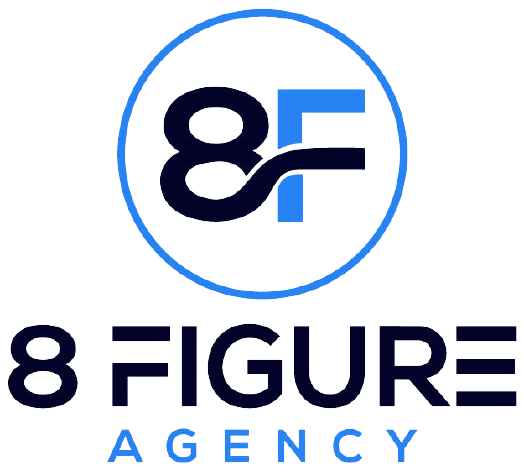The 5-5-5 framework is a popular marketing strategy emphasizing employee engagement through focus, flexibility, and freedom. It suggests allocating 50% to core marketing activities such as branding and ongoing campaigns, 25% to experimentation, allowing for the exploration of new tactics and channels, and another 25% to optimization, focusing on data analysis and refining existing campaigns.
In this guide, we’ll break down the core philosophy of the framework.
At 8 Figure Agency, we specialize in assisting agencies in achieving 8-figure success by enhancing operational efficiency, streamlining fulfillment processes, and optimizing management strategies.
Book A Free Consultation With 8 Figure Agency Today!
Importance of Empowering Marketing Teams
Going beyond the 5-5-5 framework, empowering marketing teams through employee engagement involves cultivating a culture where team members feel trusted, accountable, informed, equipped, agile, and adaptable. The value of empowering marketing teams lies in the contribution to enhanced creativity and innovation. This is because empowered teams are more confident to challenge the status quo and generate new ideas. Plus, it leads to improved decision-making, with empowered teams being in tune with the market and capable of making faster and more relevant decisions.
This approach allows increased ownership and employee engagement, as marketers who feel valued and trusted become more invested in their work and its success. All in all, empowering teams boosts morale and productivity, fostering higher job satisfaction and increased efficiency.
Evolution of Marketing Strategies
Marketing frameworks have evolved throughout history, mirroring the changing media landscape and consumer behavior. Here are some key eras and their frameworks:
- Production Era (1870s-1930s): The focus was on production efficiency and maximizing output. Frameworks like “product-push” emphasized promoting existing products rather than understanding customer needs.
- Sales Era (1930s-1950s): With increased competition, the focus shifted to persuading customers to buy. Frameworks like “AIDA” (Attention, Interest, Desire, Action) guided persuasive messaging.
- Marketing Era (1950s-present): Customer orientation became paramount. The “Marketing Concept” emerged, advocating for understanding consumer needs and tailoring products and messaging accordingly.
- Relationship Era (1990s-present): Building long-term customer relationships gained importance. Frameworks like “CRM” (Customer Relationship Management) emphasize fostering loyalty and repeat business.
- Digital Era (2000s-present): The rise of the internet and digital channels led to frameworks like the “5P’s of Online Marketing” (Product, Price, Place, Promotion, People) and “Inbound Marketing”, focusing on attracting and engaging customers online.
The Need for Adaptability in Modern Marketing
In today’s marketing, adaptability is a must to survive the rapid technological advancements, empowered consumers, global competition, and evolving data landscapes.
As marketers, you must embrace flexibility, continuous learning, employee engagement, and staying current on trends, tech, and customer insights. Data-driven decisions, experimentation, and prioritizing long-term relationships are also essential for navigating the ever-changing marketing terrain.
8 Figure Agency supports agencies in breaking free from the unpredictable feast-or-famine cycle by establishing a consistent cash flow, boosting profit margins, and ensuring the achievement of annual goals. Your agency can achieve this by implementing improved marketing and operational processes and strategic management decisions.
Book A Free Consultation With 8 Figure Agency Today!
Unpacking the Traditional Entrepreneurial Operating System 5-5-5 Framework
The Entrepreneurial Operating System (EOS) is a widely adopted business framework, particularly beneficial for entrepreneurs seeking to scale their companies sustainably. At its core lies the 5-5-5 model, emphasizing focus, clarity, and traction.
The model is explained through three key components.
Vision, Traction, and Integrators
The foundation of EOS starts with creating a clear vision (10-year ideal future) and defining 3-year Rocks (Rocks are quarterly priorities derived from the vision). 5 key roles within the leadership team (Visionary, Integrator, Controller, COO, Sales & Marketing Head) ensure alignment and execution.
Rock Reviews & Quarterly Reviews
The second component includes weekly issue-solving meetings and standardized processes, such as “Rock Reviews” and “Quarterly Reviews,”. These keep everyone accountable and on track.
Clear Communication
The third aspect, encapsulating to-do lists, communication, and people, requires aligning individual tasks with Rocks. Clear communication is fostered through tools like EOS notes. While, investing in people occurs through hiring, onboarding, and coaching for a robust team culture.
This comprehensive approach provides entrepreneurs like you with a structured yet flexible methodology for achieving sustained growth and employee engagement.
Redefining the 5-5-5 Framework: A Tailored Approach for Marketers
The 5-5-5 framework has valuable principles for marketing. But, today a one-size-fits-all approach might not be the best. Marketers can reshape the 5-5-5 framework with a nuanced focus on purpose, audience segments, and data-driven insights. While flexibility involves fostering experimentation and adapting to real-time trends it also empowers teams to make decisions using data and performance metrics.
Freedom allows investments in creativity, collaboration, employee engagement, and innovation. It creates a safe space for the encouragement of bold ideas. This redefined framework offers a holistic, adaptive approach to modern marketing challenges.
Examples of Successful Implementations
The following examples show how brands have tailored the 5-5-5 framework to their specific needs and achieved remarkable results.
- Red Bull: Their “Stratos” campaign defied gravity with Felix Baumgartner’s skydive, aligning with their brand’s adventurous spirit and pushing boundaries.
- Airbnb: They shifted their focus from “rentals” to “belonging,” creating authentic experiences and community-building initiatives.
- Dollar Shave Club: Their humorous and disruptive marketing defied traditional razor advertising, resonating with millennials and disrupting the industry.
The Three Dimensions of Employee Engagement

Empowerment, at its core, is about enabling individuals and groups to act effectively and confidently toward their goals. While often applied to individuals, true empowerment thrives in a synergistic environment where individual capabilities connect and amplify each other.
Individual Empowerment
This is the foundation, where individuals develop the skills, knowledge, and confidence to be self-directed and make meaningful contributions through employee engagement. As employers, you can provide access to training, mentorships, and resources that help individuals hone their existing skills and acquire new ones. Encouraging independent thinking, initiative, and decision-making also empowers your team to take ownership of their projects and find innovative solutions.
Team Empowerment
Individual capabilities through employee engagement, come together to form a powerful collective in a well-empowered team. When you provide your team members with shared workspaces, communication channels, and project management tools, they can facilitate smoother collaboration, knowledge sharing, and alignment.
Encouraging them to share their expertise with colleagues across different departments also breaks down silos and fosters a continuous learning environment. This creates a pool of diverse skills and perspectives, enriching collaboration and problem-solving.
Societal and Systemic Empowerment
Empowerment isn’t limited to individuals and teams.
It extends to broader societal and systemic structures, creating an environment where everyone has the opportunity to thrive. Equal access to education and healthcare enables us to develop our potential and contribute meaningfully to society. Policies that address discrimination and promote equal opportunities also create a level playing field where we can pursue our goals and aspirations. And finally, encouraging civic participation and empowering communities to make decisions that affect their lives fosters a sense of ownership and agency within society.
Technology Integration
Technology integration is no longer an option for marketing teams in the current digital landscape. Technology provides marketing teams with a powerful toolkit for empowerment, enhancing their capabilities, employee engagement, and effectiveness in many ways:
- Efficiency and Automation: Automating repetitive tasks like scheduling social media posts or email campaigns frees up time for strategic thinking and creative endeavors.
- Data-Driven Insights: Analytics platforms deliver real-time data on campaign performance, allowing teams to make informed decisions and optimize strategies constantly.
- Personalization and Targeting: Technology enables personalized marketing experiences, tailoring content and offers to specific customer segments for increased engagement and conversion rates.
- Content Creation and Distribution: Creative tools empower teams to produce high-quality content (videos, graphics, etc.) and reach wider audiences across diverse channels.
- Improved Collaboration and Communication: Platforms like project management software and instant messaging tools facilitate seamless collaboration within your teams and across departments, streamlining workflows and fostering alignment.
Tools and Platforms for Efficient Collaboration
Choosing the right tools depends on your team’s specific needs and workflow. But, the key is to ensure they integrate seamlessly with each other, creating a unified ecosystem for information sharing, project management, and communication. Here are some examples of tools and platforms that can fuel efficient collaboration within marketing teams:
- Project Management: Asana, Trello, Monday.com
- Communication and Collaboration: Slack, Microsoft Teams, Zoom
- Content Creation and Distribution: Canva, Hootsuite, Buffer, Later
- Data Analytics and Reporting: Google Analytics, Tableau, Power BI
- Customer Relationship Management (CRM): Salesforce, HubSpot, Zoho CRM
At 8 Figure Agency, our goal is to help you optimize your operations and ensure consistent employee engagement and execution from your team. If you’ve placed a priority on streamlined operations but faced challenges in implementation, now is the right time to connect with us and set yourself up for success.
Book A Free Consultation With 8 Figure Agency Today!
Metrics and Measurement
Empowering your marketing team is a must but there is still a responsibility to the company to track progress and ensure your efforts are delivering results. Here’s how to redefine success metrics and monitor your employee engagement and empowered marketing strategy.
Redefining Success Metrics
Traditional metrics like clicks and impressions might not give you the full picture when measuring the success of an empowered marketing team. Instead, consider these shifts:
- From quantity to quality: Focus on metrics that reflect deeper engagement and brand connection, like customer lifetime value, net promoter score, or social media sentiment analysis.
- From siloed to holistic: Align your metrics with your overall business goals and track how marketing contributes to revenue, customer acquisition, or brand awareness.
- From static to dynamic: Embrace experimentation and adjust your metrics as your strategy evolves. Instead of rigid targets, measure progress based on employee engagement, learning, and iteration.
- Focus on the “why” behind the numbers: Go beyond just the data and understand the context behind performance. Analyze what’s driving engagement, identify areas for improvement, and celebrate team successes and employee engagement beyond just hitting target numbers.
Monitoring and Adjusting the Empowered Marketing Strategy:
With your redefined metrics in place, here’s how to monitor and adjust your empowered marketing strategy:
- Regularly review data and performance: Set up tracking systems and reporting intervals to regularly analyze campaign performance and team progress.
- Foster open communication and feedback: Encourage employee engagement when team members share insights from their efforts and collaborate on data interpretation.
- Embrace a culture of experimentation and agility: Be willing to adjust your strategy based on data and learning. Encourage the team to test new ideas and iterate quickly.
- Celebrate both successes and learnings: Recognize positive results but also celebrate valuable lessons learned from failed experiments. This fosters a culture of continuous improvement.
- Maintain alignment with overall business goals: Ensure your metrics and adjustments ultimately contribute to the achievement of your broader business objectives.
Case Studies: Success Stories with 8 Figure Agency

Easy Button Leads
Cole Ruud-Johnson founded Easy Button Leads, a call center with over 200 staff servicing real estate investors and other industries. 8 Figure Agency helped Cole add $63,000 MRR in just 120 days. Watch that interview here:
How This Overseas Staffing Agency Added $63,000 MRR in Just 120 Days!
Porter Media
Allan Porter founded Porter Media, a marketing agency focused on scaling businesses predictably, sustainably, and profitably. 8 Figure Agency helped Allan grow by $30,000/Month in 90 days. Watch that interview here:
How This Performance Marketing Agency Grew By 30k/Month In 90 Days
Final Thoughts
Throughout this discussion, we’ve delved into empowered marketing and explored how to adapt the traditional 5-5-5 framework to fuel success.
Remember, empowering your marketing team is not a one-time action; it’s an ongoing journey of learning, adaptation, and growth. By embracing the principles of the empowered 5-5-5 framework and taking consistent steps toward implementation, you can unlock your team’s full potential and propel your brand to new heights of success.
Let’s work together to create an environment where empowered marketing teams thrive, driving exceptional results and building meaningful connections across the globe. With 800+ clients, 300+ 7-figure clients, and 3000+ jobs created, 8 Figure Agency has the proven results to help you scale your agency.
Book A Free Consultation With 8 Figure Agency Today!



















































